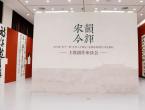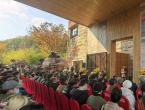How to understand Russian avant-garde?
Art Daily: After reading the name of the exhibition, may I ask how Russian avant-garde was born?
Xiao Feige (hereinafter referred to as Xiao): At the beginning of the 20th century, the world was changing rapidly, science and technology were iterating and updating, and new trends were also emerging in fields such as art, philosophy, and literature. Breaking the old and establishing the new became the theme of the times. In 1917, the October Revolution broke out, and many Russian artists, with a passion for change, devoted themselves unwaveringly to the construction of new environments, education, and organizations, hoping to bring new culture and life to the country through the power of art. Therefore, Russian avant-garde art emerged.
Art Newspaper: Why is Russian avant-garde important in art history?
Xiao: Academically speaking, abstract art is a very important genre in the turning point of art history. Although Russian avant-garde was short-lived, it had a huge impact on the development of the entire art history. For example, among the four artists in this exhibition, Kandinsky is the founder of "hot abstraction", while Malevich is the founder of "cold abstraction".
Secondly, the influence of avant-garde is not only within art history, but also radiates to fields such as design and architecture, having a profound impact on modern architectural design, industrial product design, and so on. The exhibits we are exhibiting this time include ceramics and architectural models. To some extent, avant-garde has allowed the concept of art as a temple to truly connect with people's daily lives, providing a foothold for art in people's daily lives and aesthetics. So, this exhibition is called "Dawn of the Century" because avant-garde pioneered modern Russian aesthetics. Another implication is that at the beginning of the 20th century, with the changing economic, political, and social conditions, new discoveries and developments in technology, literature, and thought emerged one after another, and avant-garde became an art school that emerged during the world's great changes. Russian avant-garde artists also hope to transform the old society through art, creating a new, more beautiful, and better order of life. These artists are full of passion and ideals.
Art Newspaper: Could you please introduce what abstract art aesthetics are?
Xiao: The theme of abstract art is actually quite challenging for the audience. We often find it difficult for them to understand in the exhibition hall because Chinese audiences are more familiar with concrete art. As is well known, abstract thinking is the key for humans to transcend surface phenomena and deeply grasp the essence of things. Art, as the spiritual flower of human civilization, has been constantly deepening its connection with the world - from objective depiction of reality to subjective expression of emotions, and further expanding to abstraction's extraction and summary of the essence of things. Therefore, abstract art aesthetics is a process that mobilizes both sensibility and rationality, and is a more complex, profound experience that requires deep audience participation. It is not only a resonance between the audience and the artist, but also an inspiration for the audience's imagination.
Art Newspaper: How to understand abstract art and appreciate abstract art works?
Xiao: For audiences who do not have abstract art aesthetic experience, we need to understand some background information and supplement it with prerequisite knowledge. For example, in this exhibition, a large amount of text is given, and audiences can read the wall text or establish a foundation of rational cognition by scanning the code. Then when we look at these works again, we will feel more familiar and familiar. But when your aesthetic and visual experience accumulates to a certain extent, you will find that appreciating abstract art is an easy thing, and at the same time, you can understand its internal logic.
For example, Malevich, the works displayed in the exhibition hall may have geometric tones. But in fact, if we learn about his words, we will find that he lived in an era where Russia began to have large-span buildings based on geometric shapes. He abstracted the characteristics of these buildings and placed them on a white background, which was like an endless universe to him. So it highly abstracts and spiritualizes concrete objects and combines them together, reflecting a very pure world.
To give a more straightforward and concrete example, if you see a girl today, she may have long hair, big eyes, and a round face. Her character is very kind, brave, and upright. Perhaps many years later, when you recall this girl again, you may not remember whether she had long or short hair, round or pointed face, big or small eyes, but you still remember her: she was brave, kind, and upright, and her qualities would not change just because she was in Chengdu today, in Hangzhou tomorrow, or anywhere in the world. This is the essence and trait of things or objects. What Malevich wants to express is to use color and shape to reflect and summarize this trait, rather than details. He doesn't want to depict the object's long hair, big eyes, and round face, but rather to express the feelings that the object gives him: courage, kindness, and integrity. Perhaps for him, red represents passion, while white represents purity. He summarizes and abstracts through this kind of thing, which is an auxiliary understanding.
Copyright Notice: Original content on this website is welcome to be reposted. Please indicate the source when reposting, Global Art Network www.caanets.com; Some of the content posted on this website comes from the internet. If there is any infringement, please contact this website to delete it.




